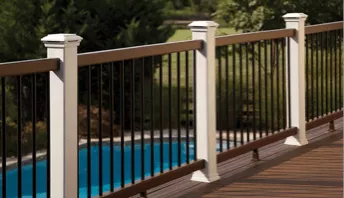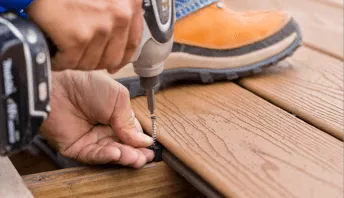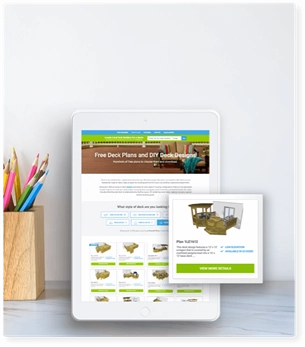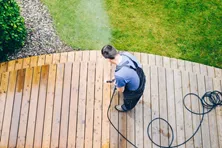Laying Out the Deck Ledger Board
Before driving the structural screws to firmly attach the ledger, be sure to draw your joist locations onto the face of the ledger. The reason for laying out the joist locations is to prevent placing a joist on top of a structural bolt holding the ledger in place. In the case of a rectangular deck, you could lay out the joists on the ledger (on a set of sawhorses) before you install it. But if the deck will have a number of angles or is very long, it is easier if you lay out with the ledger installed on the house first.

Read this article to determine your joist spacing. (In our example, joists are 16" on center to support 5/4 pressure-treated decking laid perpendicular to the joists.) Joists are usually installed “on center,” meaning the spacing number – usually, 16" or 12" – falls in the center of the joist’s thickness.
At the end of the ledger, the outside joist will butt into the face, rather than the end, of the ledger. Here, the ledger is marked for an outside joist that will be doubled. This double joist will require a double-concealed joist hanger. You cannot use a standard joist hanger at the end of a ledger, as it's cut flush with the edge of the ledger board. A standard joist hanger requires an extra 1.5" of space to nail to the ledger.
Attaching the Ledger Board to the House Rim
Learn how to properly install a waterproof ledger board using flashing and fasteners. Check out our step-by-step video and detail drawings.
Removing the Siding
Learn the right way to remove vinyl siding for ledger board installation—without damaging your home’s exterior. Step-by-step guide with pro tips!
Installing A Ledger Board Around A Corner
Follow our tips to properly install a deck ledger board around the corner of a house to keep water out.
How to Avoid, Prevent & Repair Deck Joist Rot
Rotted deck joists can cause homeowners headaches. Learn more about how to avoid, prevent and repair deck joist rot at Decks.com.
Deck Replacement & Repair Costs
Whether you’ve decided to tear down and rebuild your deck or if you’re only looking to repair smaller portions, you can find benchmark prices here.
More Helpful Resources
Explore Articles by Topic

Footings
Information related to installing frost footings for decks

Framing
Learn structural framing methods

Decking
Learn about wood and composite decking materials

Stairs
An in-depth look at the complex issue of how to build stairs

Railings
How to install guardrails and handrails to meet IRC code

Features
An overview on water drainage, benches, planters and lights

Design
The basics of deck design

Planning
Learn about permits and working with contractors

Porches & Patios
Build a covered deck to enjoy all seasons

Ledger
Proper attachment techniques

Care
Maintain your deck to maintain your investment

Materials
An overview on water drainage, benches, planters and lights
Attaching the ledger board to hollow block
Our inspector discusses how to attach a deck to a hollow concrete block foundation wall.
Attaching the Ledger Board to Brick Siding
Do you have brick siding? You should never attach to just the brick. This is very dangerous.
Ledger Board Fasteners
Compare types of deck ledger board fasteners like lag bolts, through bolts & structural screws. Learn how to choose the right fastener for your ledger board.
How to Remove Scuffs and Scratches from Composite Decking
Removing scuffs and scratches can help make your composite deck look like new. Learn how to fix and prevent your composite deck from future scratches.
Preventing & Treating a Slippery Deck
Inclement weather can cause both wood and composite decks to become slippery and potentially unsafe. Learn how to prevent and treat a slippery outdoor deck at Decks.com.
How to Remove Moss & Algae from Your Deck
Moss and algae growth can be detrimental to the integrity of your deck if left untreated.
Explore Articles by Topic

Footings
Information related to installing frost footings for decks

Framing
Learn structural framing methods

Decking
Learn about wood and composite decking materials

Stairs
An in-depth look at the complex issue of how to build stairs

Railings
How to install guardrails and handrails to meet IRC code

Features
An overview on water drainage, benches, planters and lights

Design
The basics of deck design

Planning
Learn about permits and working with contractors

Porches & Patios
Build a covered deck to enjoy all seasons

Ledger
Proper attachment techniques

Care
Maintain your deck to maintain your investment

Materials
An overview on water drainage, benches, planters and lights





















